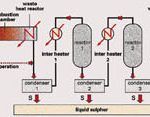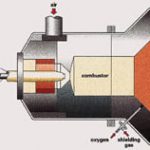In refineries, liquid fuels are typically desulphurized using so-called hydro-treaters. The hydrogen sulphide which is produced is converted to elemental sulphur in a Claus sulphur-recovery process. The performance of this process can be improved by replacing some or all of the combustion air with pure oxygen.
Dr. Ing. Gerhard Groß
Conventional oxygen-enrichment processes and pure-oxygen-based processes either offer only limited potential for increasing plant capacity or the necessary reconstruction work makes them un-duly expensive.
An industrial gas company has developed and patented a post-combustion process using pure oxygen in co-operation with Raffineriegesellschaft Vohburg in Ingolstadt, Germany. The technology combines a high throughput with low capital costs.
Introduction
In refineries, hydrogen sulphide is typically formed from sulphur as a mixture with hydrogen and hydrocarbons with a higher molecular weight. In amine washers, for example, the so-called “Claus gas” which is produced has a hydrogen sulphide concentration of up to 90% by volume. Other sources of hydrogen sulphide include the sour water from stripper columns. This is an aqueous condensate with a hydrogen sulphide concentration of up to 50% by volume.
Hydrogen sulphide is also produced as a result of the gasification of coal or heavy oil in so-called combined gas and steam power generators, whilst natural gas can contain up to 30% hydrogen sulphide. Since there are almost no industrial applications for hydrogen sulphide, it is converted first to elemental sulphur and then in special units to sulphuric acid. An important commercial process for converting hydrogen sulphide to elemental sulphur and hydrogen was patented in England as early as 1883 by Carl Friedrich Claus. The equation for the overall reaction is:
H2S + 1/2 O2 + 1,9 N2 Þ S + H2O + 1,9 N2 (1)
Clearly, the nitrogen in the combustion air is merely a diluent.
The original process comprised only a single catalytic reactor. Around 1930, IG Farbenindustrie significantly increased the throughput, as well as the conversion efficiency from hydrogen sulphide to sulphur, by adding a thermal reactor with a waste heat boiler. This process, sometimes known as the modified IG-Claus process, is the basic technology employed by more than 2000 units currently operating worldwide.
Oxygen in Claus units
In many refineries, the desulphurization capacity of the Claus unit is a significant bottleneck. This can be a consequence of capacity increases elsewhere in the plant, the use of low-cost crude oil with a high sulphur content or reductions in the permitted level of sulphur in fuels, such as the recent reduction in the sulphur content of diesel from 0.2% to 0.05%. If the quantity of process gas to be treated increases, the pressure drop across the unit increases. This reduces the dwell-time in the reactor, which in turn can lead to combustion reactions occurring outside the combustion chamber, namely in the boiler or in the catalytic reactor.
As can be seen from the reaction equation (1), if atmospheric air is used as the oxidant, 60% of the process gas is nitrogen. This inert ballast makes a significant contribution towards the pressure drop across the unit. In order to achieve a specific desulphurization capacity, the plant therefore has to be correspondingly over-sized.
Modifying or replacing the Claus unit in order to increase the desulphurization capacity can be avoided by using pure oxygen as an additional oxidant. If the increase in the hydrogen sulphide throughput is production-related, the combustion air can be supplemented or replaced by pure oxygen. The use of oxygen to de-bottleneck Claus units is now a standard approach.
Theoretically, three times as much sulphur can be converted as before by using pure oxygen as the oxidant instead of air, if the process gas volume remains unchanged. Unfortunately, the associated increase in the combustion temperature prevents this capacity increase from being realized without major modifications to the plant. In practice, two different approaches have been developed: firstly, limited oxygen enrichment of the combustion air and, secondly, pure oxygen processes.
Oxygen enrichment
Oxygen enrichment of the combustion air is the simplest oxygen technology. In an initial approximation, the potential increase in the hydrogen sulphide throughput is proportional to the amount of oxygen added. How-ever, the operating temperature of the burners is increased by oxygen addition. The maximum operating temperatures of the burner, the boiler and the first condenser therefore limit the quantity of oxygen which can be added. Experience has shown that, depending on the exact construction principle, oxygen concentrations of up to 28% can normally achieved by modifying the existing burner, boiler or condenser. This allows the sulphur throughput for a rich gas to be increased by 25%.
Pure oxygen processes
The capacity can be increased by using up to 100% pure oxygen if appropriate modifica-tions are made to the plant. The burner, combustion chamber, boiler and circulating fan, amongst other components, must be modified or replaced. Their cost is equivalent to 30% of the total cost of a Claus unit.
The processes which can be operated at up to 100% oxygen in a Claus unit include the COPE and SURE processes as well as the LURGI Claus oxygen burner. The latter can be operated with air, oxygen enrichment or pure oxygen.
Oxygen post-combustion process
For many operators of Claus units, the maximum capacity increase of 25% that can be achieved through oxygen enrichment is insufficient, yet the use of 100% pure oxygen is uneconomical, because the additional capacity is not required continuously. Together with Raffineriegesellschaft Vohburg in Ingolstadt, an industrial gas company based in Krefeld, Germany, has developed and tested a patented process which offers capacity increases to fill the gap between oxygen enrichment and 100% pure oxygen. The cost of the conversion is less than 1% of the capital cost of a new plant.
During this process, an additional post-combustion zone is created within the existing combustion chamber by means of high-turbulence oxygen jets. The additional oxygen is injected into the chamber through separate oxygen nozzles (Fig. 3). The process gas, which leaves the burner or combustor either pre-mixed or partially reacted with air, then undergoes complete combustion in the post-combustion zone. The reactions in the combustion chamber occur close to the thermodynamic equilibrium.
The sulphur capacity can be increased by approximately 55% using this process. This is equivalent to an oxygen enrichment of 45% by volume (Fig. 4). The operating temperatures of those components of a Claus unit which are most relevant to operating safety – the burner, combustion chamber, boiler and catalytic reactor – remain within the maximum permissible values. In practice, this process leads to an increase in the service life of the first reactor. At the temperatures of no more than 550 °C which are typical in this stage, the excess oxygen which is present in conventional processes reacts catalytically with the SO2 to produce SO3. This in turn reacts with the aluminium oxide catalyst pellets to form aluminium sulphate, which deactivates the catalyst. By ensuring that the minimum temperature of 1350 °C required in particular for the combustion of ammonia is reached, the higher combustion temperatures also ensure the complete decomposition and combustion of ammonia and hydrocarbons with a high molecular weight.
Furthermore, oxygen post-combustion produces an increase of 0.3% in conversion efficiency compared to conventional operation with atmospheric air.
Messer Griesheim
Fax: ++49/2151/379-115
Further information cpp 206
Unsere Webinar-Empfehlung
Die Websession „Wasserstoff in der Chemie – Anlagen, Komponenten, Dienstleistungen“ (hier als Webcast abrufbar) zeigt technische Lösungen auf, die die Herstellung und Handhabung von Wasserstoff in der chemischen Industrie sicher machen und wirtschaftlich gestalten.
Ob effizienter…
Teilen:













